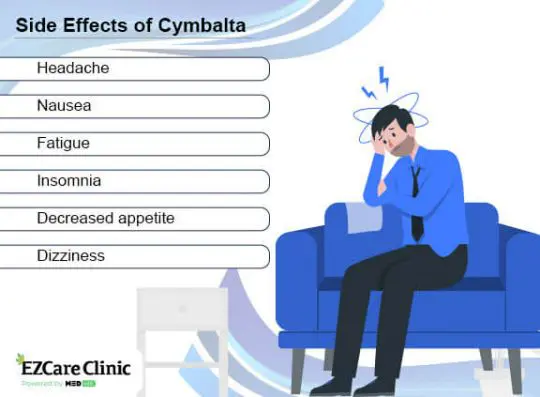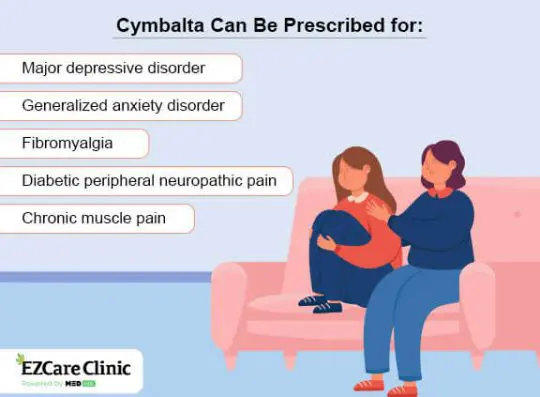The medications listed on this website are provided for informational purposes only. Their inclusion does not guarantee that they will be prescribed to any individual, as treatment decisions are ultimately at the discretion of healthcare providers. This list is not exhaustive, and healthcare providers may prescribe other medications, including non-stimulant options, based on the patient's unique health circumstances and needs.
Cymbalta is an
Serotonin and norepinephrine are chemicals in the brain that affect one’s mood. Cymbalta and other SNRIs block the uptake of these chemicals, which increases their levels in the brain and helps to treat anxiety and depression. Let’s learn more about these uses and other features of Cymbalta.
Consult EZCare doctors to know what medication will help you best.
Uses of Cymbalta
Off-label uses of Cymbalta include
Treatment of Depression
Doctors usually prescribe Cymbalta to people with major depressive disorder. Duloxetine is an effective medical drug for treating depression because it’s a dual reuptake inhibitor formulated for blocking serotonin and norepinephrine reuptake. It leads to increased activity of these chemicals.
Cymbalta for Anxiety
Cymbalta has also shown
Duloxetine for Pain Management
Cymbalta has also proven helpful in treating pain from a variety of conditions, such as:
- Peripheral neuropathic pain. Common among adults with diabetes. Taking duloxetine can help reduce pain arising from the affected nerves in the extremities.
- Fibromyalgia. It is also managed by duloxetine which is characterized by pain in the musculoskeletal region. It is usually widespread and often accompanied by fatigue and sleep.
- Joint pain. Other duloxetine uses include managing
conditions such as osteoarthritis[6] that causes painful joints.

Cymbalta Dosage
Cymbalta is available in delayed-release capsule form in doses of 20, 30, or 60 milligrams and is taken orally. Doctors typically prescribe varying doses of Cymbalta depending on the condition. The physician can adjust the dosage if the patient has other underlying conditions, such as liver or kidney dysfunction.
A typical adult dose of duloxetine is:
- 40 to 60 milligrams as an initial dose to 60 milligrams maintenance dose when treating depression, but it can go up to a maximum dose of 120 milligrams per day.
- 60 milligrams as an initial dose when treating an anxiety disorder. The doctor may raise the dosage to 120 milligrams if needed.
- 30 to 60 milligrams a day when treating pain-related complications. A daily target and maximum dose are 60 milligrams.
See a mental health expert to go through a detailed assessment of your symptoms and get a diagnosis and a treatment plan online.
Cymbalta Side Effects
Like other drugs, the use of Cymbalta can lead to minor or severe side effects.
Duloxetine can make one have suicidal thoughts in the early phases of treatment. Patients who experience symptoms related to suicidal thoughts arising from depression, extreme worry, and aggressive or hostile behavior should see the doctor immediately before the symptoms worsen.
Other less severe side effects of duloxetine include:
- Headache
- Nausea and vomiting
- Fatigue
- Insomnia
- Decreased appetite
- Weight loss or gain
- Sexual dysfunction
Cymbalta Withdrawal
Abrupt discontinuation of duloxetine use is not advisable as it can cause withdrawal effects. Their severity may vary depending on how long the treatment lasted. Common
- Tinnitus (ringing in the ears)
- Fatigue
- Headaches
- Dizziness
- Heart palpitations
- Nausea
- Vomiting
- Diarrhea
- Irritability
- Nightmares
- Sensory disturbances (such as having shock-like sensations)

Foods to Avoid When Taking Cymbalta
Some antidepressants interact with some chemicals, such as tyramine. It is commonly found in foods like cheese and fruits. The tyramine amino acid can inhibit the breakdown of these drugs, which can lead to a hypertensive crisis. Unlike most antidepressants, Cymbalta doesn’t interact with these amino acid groups. Therefore, patients can continue with their regular diet while taking duloxetine. However, please note that using the drug while taking alcohol can lead to interactions, resulting in liver damage.
Final Word
The FDA approved Cymbalta (duloxetine) to treat mental issues such as anxiety and depression among adults. It is an effective medical drug that stops serotonin and norepinephrine reuptake.
While taking Cymbalta, watch out for severe side effects, especially suicidal thoughts. If you experience suicidal thoughts, contact your doctor instantly. Also, always consult a doctor for directions on the correct dosage.
To know what medication will help you overcome your symptoms, book an appointment with EZCare doctors today.
Sources
- Duloxetine (marketed as Cymbalta) Information. (2014)
Source link - Duloxetine. (2023)
Source link - Preliminary Results on the Off-Label Use of Duloxetine for the Treatment of Stress Incontinence after Radical Prostatectomy or Cystectomy. (2006)
Source link - The role of duloxetine in the treatment of anxiety disorders. (2008)
Source link - Duloxetine in the treatment of generalized anxiety disorder. (2009)
Source link - Efficacy and safety of duloxetine in osteoarthritis: a systematic review and meta-analysis. (2019)
Source link - Symptoms following abrupt discontinuation of duloxetine treatment in patients with major depressive disorder. (2005)
Source link
Expert help for mental health issues.
Get treatment from licensed healthcare professionals.







